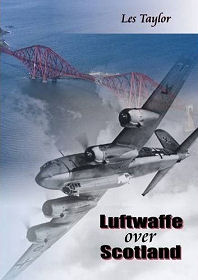 |
Les Taylor's "Luftwaffe Over Scotland, A History of German Air Attacks on Scotland, 1939-45" is an excellent book which sets out an engaging, measured and carefully researched account of the air war over Scotland during World War II. The period covered is within the memory of many still around today, so it is sometimes surprising to realised that even such a fairly recent period of history can have generated myths, legends and simple errors: and Les Taylor is to be congratulated in setting the record straight in his chronological treatment of his subject.
In doing so he takes a balanced and deliberately dispassionate approach. The book begins with a chapter on the Douhet theory, the philosophy which led the powers that be on both sides in WWII to believe that the bombing of civilians from the air was a legitimate way of waging war. As the book develops Les Taylor points out the profound flaws that emerged with the theory when it was put into practice.
Perhaps the most fascinating aspect of the book is the way, time and again, it succeeds in throwing new and unexpected light on the subject. The raids on Clydebank and Glasgow in March 1941 were the most lethal and damaging of the war in Scotland. What is fascinating is the author's analysis of why nearly identical raids on Greenock six weeks later were far less effective. This turns out in part to have been to the lighting of huge diversion fires inland to attract the Luftwaffe bombers: but in large measure it was because of the previously unheralded role of a squadron of Boulton Paul Defiant aircraft, training to be night fighters at Ayr, on the approach path of the attacking aircraft. This aircraft type has largely been written off by history as useless: but it scattered the bombers and saved Greenock in early May 1941.
Also compelling is the sense of the futility of war which emerges. Luftwaffe aircraft repeatedly attacked civilian targets in Scotland in pursuit of an obviously flawed theory, and in the process killed over 2,500 people while suffering over 200 aircraft losses themselves. And quite who decided it was a good idea for the Luftwaffe to try to attack shipping off north-east Scotland on 21 April 1945, a few days before hostilities ceased, is unclear. What is clear is that 18 aircraft took off from Stavanger, and after encountering a force of 42 Mosquito fighter-bombers based at Banff only four of the German aircraft made it back to Norway. What was the point of this at this stage of the war? But then what was the point at any stage of the war?
InformationPaperback: 160 pagesWhittles Publishing www.whittlespublishing.com 27 April 2010 ISBN-10: 1849950008 ISBN-13: 978-1849950008 Size: 23.8 x 16.8 x 1 cm Buy from Amazon (paid link) Visit Bookshop Main Page |
